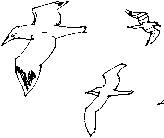 Sandwich Turns Sandwich Turns
Whitby, North Yorkshire, Holiday Diary, Thursday 17th June 1999
 HERRING GULLS wheel around the end of the West Cliff. Their easy, relaxed flight at first gives the impression that they are easy, relaxed individuals, but, as soon as one discovers a discarded morsel, it is challenged, and usually removed, by another gull. It usually manages a couple of quick bites as it glances anxiously skyward.
HERRING GULLS wheel around the end of the West Cliff. Their easy, relaxed flight at first gives the impression that they are easy, relaxed individuals, but, as soon as one discovers a discarded morsel, it is challenged, and usually removed, by another gull. It usually manages a couple of quick bites as it glances anxiously skyward.
There seems to be a pecking order amongst the 20 or 30 (at least) Herring Gulls that are circling here. While I can't make them out as individuals, the gulls themselves can. At least that was the opinion of Tinbergen who studied them in their nesting colonies. He suggested the slight differences in facial features might help the gulls with recognition.
 A single Fulmar, a relative of the albatross, flies by. It is probably nesting nearby on the cliff. The rise of these tube-nosed seabirds since the Second World War appears to be linked with the growth of the fishing industry.
A single Fulmar, a relative of the albatross, flies by. It is probably nesting nearby on the cliff. The rise of these tube-nosed seabirds since the Second World War appears to be linked with the growth of the fishing industry.
 The odd Rook is a feature of the seafront here. They remind me of Victorians in tail-coats and black shoes, taking a seaside holiday. Whitby was famous for its Victorian Jet jewellery industry, and is the place where Dracula lands in the Bram Stoker novel.
The odd Rook is a feature of the seafront here. They remind me of Victorians in tail-coats and black shoes, taking a seaside holiday. Whitby was famous for its Victorian Jet jewellery industry, and is the place where Dracula lands in the Bram Stoker novel.
 For our last lunch of this seaside holiday we go for haddock and chips and mushy peas in a cafe overlooking the entrance to the harbour. A traditional meal described by Bill Bryson as not 'so much a meal as an invitation to a heart attack, but . . delicious.'* On one side we have a panorama of sandy beach and blue sea, on the other a hairpin bend climbs the cliff by the old lifeboat station. On a flat roof behind it a pair of the gulls have reared three grey, downy chicks.
For our last lunch of this seaside holiday we go for haddock and chips and mushy peas in a cafe overlooking the entrance to the harbour. A traditional meal described by Bill Bryson as not 'so much a meal as an invitation to a heart attack, but . . delicious.'* On one side we have a panorama of sandy beach and blue sea, on the other a hairpin bend climbs the cliff by the old lifeboat station. On a flat roof behind it a pair of the gulls have reared three grey, downy chicks.
* If you're cussed enough to go for the healthy option while you're in Whitby, our favourite place was the Shepherd's Purse seafood and wholefood restaurant.
Richard Bell,
wildlife illustrator
E-mail; 'richard@daelnet.co.uk'



 Next day
Previous day
Nature Diary
Wild West Yorkshire home page
Next day
Previous day
Nature Diary
Wild West Yorkshire home page
|